VII - Alimentary Tract
Editors: Mills, Stacey E.
Title: Histology for Pathologists, 3rd Edition
Copyright 2007 Lippincott Williams & Wilkins
> Table of Contents > VII - Alimentary Tract > 28 - Liver
function show_scrollbar() {}
28
Liver
Arief A. Suriawinata
Swan N. Thung
Introduction
The embryology, gross morphology, and histology of the normal human liver the single largest organ in the human body are described in this chapter. It is emphasized that liver biopsy specimens must be processed with special care in order to obtain optimal sections for diagnostic histologic evaluation. In many instances, immunohistologic studies of liver tissue have the potential to yield more information than electron microscopy. In surgical and autopsy liver specimens, nonspecific histologic alterations may be prominent, but they often have little significance. On the other hand, some morphologic changes, particularly in needle biopsy specimens, are frequently subtle but may be of diagnostic importance. The pathologist must be familiar with these histologic variations of and from the normal liver.
Embryology
The liver arises as the hepatic diverticulum from the endodermal lining of the most distal portion of the foregut during the third to fourth week of gestation (1,2,3). In embryos 4 to 5 mm in length, the hepatic diverticulum differentiates cranially into proliferating hepatic cords and caudally into the gallbladder and extrahepatic bile ducts. The anastomosing cords of hepatic epithelial cells grow into the mesenchyme of the septum transversum. As the hepatic cords extend outward during the fifth week of gestation, they are interpenetrated by the inwardly growing capillary plexus, which arises from the vitelline veins in the outer margins of the septum transversum and forms the primitive hepatic sinusoids.
Scattered mesenchymal cells derived from the septum transversum lie between the endothelial wall of the
P.686
sinusoids and the hepatic cords and form the connective tissue elements of the hepatic stroma, as well as the capsule, which is covered by a mesothelial layer. Hematopoietic tissue and Kupffer cells also derive from splanchnic mesenchyme of the septum transversum. Once these structures are established, the liver grows rapidly to fill most of the embryonal abdominal cavity and by nine weeks' gestation accounts for approximately 10% of the total weight of the embryo (4). The bile canaliculi appear in the 10-mm embryo as intercellular spaces between immature hepatocytes (hepatoblasts).
The epithelium of the intrahepatic bile ducts arises from the proximal part of the primitive hepatic cords. This process is largely determined by the progressive development and branching of the portal vein with its surrounding mesenchyme. First, the epithelial layer in direct contact with the mesenchyme around the portal vein transforms into bile duct type cells. Then a second layer transforms into bile duct epithelial cells, resulting in a circular cleft in the shape of a cylinder around the portal vein and its enveloping mesenchyme (Figure 28.1). This primitive channel duct in the 8-mm embryo (five to six weeks of gestation) is termed the ductal plate (5), which then undergoes gradual remodeling to form the normal anastomosing system of bile ducts in the portal tracts (6,7). The differentiation of intrahepatic ducts is recognized in embryos of 22 to 30 mm. Despite the common ancestry of hepatic parenchymal cells and ductal epithelium, each cell type is structurally and functionally distinct. The walls of the terminal twigs of the biliary tree, the canals of Hering, which connect bile canaliculi to bile ducts, include both typical hepatocytes and bile duct cells, without intermediate forms.
Functionally, intrahepatic hematopoiesis begins during the sixth week, hepatocyte bile formation by the twelfth week, and excretion of bile into the duodenum by the sixteenth week. The third trimester marks the cessation of hematopoiesis with a concomitant decrease in liver growth so that the liver accounts for approximately 5% of the newborn's body weight.
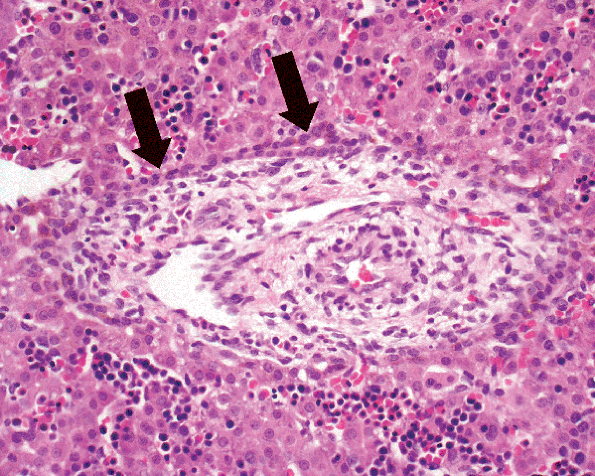 |
Figure 28.1 Ductal plate (arrows) developing around the portal vein mesenchyme in the liver of a 10-week-old embryo. There is extramedullary hematopoiesis in the sinusoids. |
Apoptosis
Apoptosis occurs at all stages during fetal growth and development of ductal plates and hepatoblasts. There is a good correlation between the proliferative and the apoptotic activities in the ductal plate, depending on the remodeling process (8). Involution of liver hyperplasia and neoplasia (9,10,11,12) also is controlled by apoptosis, which is induced by transforming growth factor- 1 (11,12,13). In these regressing livers or tumors, scattered apoptotic bodies, rather than massive lytic necrosis, are observed. In viral infections, such as cytomegalovirus and herpes hepatitis, apoptosis has been proposed as a mechanism of cell death. In viral hepatitis B, however, it is not clear if cell death is mediated directly by the virus or by the host immune system through the release of cytokines such as tumor necrosis factor-a to the infected cells (14). In normal liver tissue, although rare, individual apoptotic bodies may be seen, which suggests that apoptosis is a physiological process in the liver (15) (Figure 28.2).
Gross Morphology
The liver of an adult weighs 1400 to 1600 g, comprising 2% of the body weight (3,16). It is relatively larger in infancy, representing one-eighteenth of the birth weight, mainly
P.687
due to a large left lobe. The liver resides predominantly in the abdominal right upper quadrant and is completely protected by the rib cage. It extends from the right fifth intercostal space in the midclavicular line down to the right costal margin and to the left as far as the left midclavicular line. It has the appearance of a wedge with the base to the right and measures about 10 cm in vertical span, 12 to 15 cm in thickness, and 15 to 20 cm in its greatest transverse diameter.
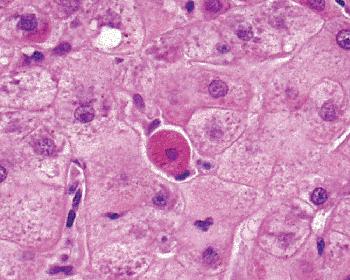 |
Figure 28.2 An hepatocyte undergoing apoptosis. |
It is divided by deep grooves into two large lobes the right (lateral to falciform ligament) and left (medial to falciform ligament) and two smaller lobes the caudate and quadrate lobes. This traditional division is only of topographical significance. Functionally, the division into eight segments, which do not correspond to the anatomical division into lobes (17), is more important. Each segment is served by its own vascular pedicle of arterial and portal venous blood supply and branch of the biliary tree. This segmental division is of critical importance, particularly when dissecting small space-occupying lesions from these areas or when removing segments of liver for transplantation. The superior, anterior, and lateral surfaces of the liver are smooth and almost completely covered by peritoneum, except for a small triangular area the bare area below the diaphragm which is surrounded by the reflections of the peritoneum forming the coronary ligaments. A thin layer of fibrous connective tissue, the Glisson's capsule, surrounds the liver and extends into the parenchyma to form extensions that support arterial and biliary structures. Anteriorly, the falciform and round ligaments, which during fetal life conducted the left umbilical vein, connect the liver to the abdominal wall. Through the posterior surface of the liver at the base of the bare area runs the inferior vena cava, to which two to four hepatic veins connect. The fossa of the gallbladder and the round ligament separate the quadrate lobe from the right and left liver lobes, respectively. The fossa of the ductus venosus (i.e., the connection of the left umbilical vein to the vena cava inferior) and the inferior vena cava separate the caudate lobe from the left and right lobes of the liver. The horizontal portal fissure (or porta hepatis), which joins the upper ends of the gallbladder fossa and the groove of the round ligament, contains the branches of the hepatic artery, the portal vein, the hepatic nerve plexus, the hepatic ducts, and lymph vessels.
Anatomy
Blood Supply and Drainage
The liver is nourished by a dual blood supply, approximately three-fourths via the portal vein and the remainder via the hepatic arteries. The portal vein carries venous blood from the alimentary tract, including the pancreas, which is rich in nutrients; whereas the hepatic artery supplies arterial blood from the celiac axis that is rich in oxygen for liver survival.
Venous outflow is provided by the right, middle, and left hepatic veins. The right hepatic vein drains the right lobe, the middle hepatic vein drains primarily the middle portion of the left lobe and a variable portion of the right, and the left hepatic vein provides the principal drainage of the left lateral lobe. The middle and the left hepatic veins often join together to form a common trunk before entering the vena cava. In addition, there are short venous segments that drain the posterior surface of the liver directly into the inferior vena cava (18).
Bile Ducts
Bile ducts accompany the hepatic artery and portal vein while coursing through the liver. They are nourished by the hepatic arteries via a complex peribiliary plexus of capillaries, which supplies all structures within the portal tracts. Bile is formed in hepatocytes, steadily secreted into bile canaliculi, canals of Hering, and then to the intra- and extrahepatic bile ducts. The extrahepatic biliary tract consists of a gallbladder that ends in the cystic duct. The cystic duct joins the hepatic duct to form the common bile duct, which enters the second portion of the duodenum through its muscular structure, the sphincter of Oddi (19).
Lymphatics
The capsule and the stroma of the liver is rich in lymphatic structures. The lymphatic plexus found in the capsule forms significant anastomoses with the intrahepatic lymphatics. The importance of these anastomoses is evident when hepatic venous pressure is increased; exudation of excess lymph from the capsular plexus forms protein-rich ascitic fluid. The intrahepatic lymphatic system exists as a fine, valved plexus associated with branches of hepatic artery in portal tracts. Hepatic lymph is most likely formed in the interstitial space of Disse. Lymphatic capillaries are not observed within the acini (20,21). Most of the hepatic lymphatics leave the liver at the porta hepatis and drain into hepatic nodes along the hepatic artery and into the celiac nodes. Other important efferent routes are via the falciform ligament and the superior epigastric vessels to the parasternal nodes, from the bare area to posterior mediastinal nodes, and from the visceral surface to the left gastric nodes.
The liver represents the largest single source of lymph in the body, producing 15 to 20% of the overall total volume (22) and 25 to 50% of the thoracic duct flow (21). Furthermore, hepatic lymph has an unusually high protein content, about 85 to 95% of that in plasma, and a high content of lymphocytes.
P.688
Nerve Supply and Innervation
The liver is innervated by two separate but intercommunicating plexuses around the hepatic artery and portal vein and are distributed with their branches (23). They include parasympathetic fibers from both vagi and sympathetic fibers, which receive their preganglionic connections from spinal segments T7 to T10 (24). The hilar plexuses also include afferent visceral and phrenic fibers. Besides their presence around vascular structures in portal tracts, nerve fibers (mostly sympathetic) are present in the parenchyma along the sinusoids. Release of neurotransmitters from the intrasinusoidal fibers modulate hepatocyte and perisinusoidal cell function. It controls in part carbohydrate and lipid metabolism and induces contraction of perisinusoidal cells, thereby regulating intrasinusoidal blood flow (25). However, neural mechanisms may have only a minor regulatory role because limited reinnervation in liver allografts does not seem to impair their function. Denervation probably explains the impaired normal response of the liver to ischemia, sinusoidal dilatation seen in liver allografts, and impaired metabolic function in cirrhosis (26,27).
Histology
The structural organization (16,28,29,30,31) of the liver into parenchymal, interstitial, vascular, and ductal elements is based on its many functions and its position between the digestive tract and the rest of the body. The functional unit of the liver is represented by the hepatic lobule or rather, as defined by Rappaport (3,32), the hepatic acinus (Figure 28.3). The latter is a regular, three-dimensional structure in which blood flows from a central axis, formed by the terminal portal venule and terminal hepatic arteriole in the portal tract, into the acinar sinusoids and empties into several terminal hepatic venules at the periphery of the acinus (Figure 28.4).
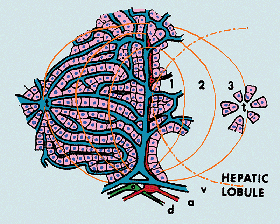 |
Figure 28.3 Diagram comparing the hepatic acinus with zones 1, 2, and 3 to the hepatic lobule (dotted line). Portal tract contains portal venule (v), hepatic arteriole (a), and hepatic duct (d). (t, terminal hepatic venule) |
 |
Figure 28.4 Normal human liver showing two portal tracts (arrows) and one terminal hepatic venule (arrowhead). |
In contrast, the hepatic lobule consists of an efferent central vein with cords of hepatocytes radiating to several peripheral portal tracts (33). Therefore, in a two-dimensional view, the acinus occupies parts of several adjacent lobules. The acini measure 560 to 1050 m in length and 300 to 600 m in width. The division of the hepatic parenchyma into the classic lobules, with changes described as being centrilobular, midzonal, and peripheral or periportal, is still used as a convenient landmark. However, Rappaport acinus has now come to be more generally accepted. The acinus is subdivided into zones 1, 2, and 3 with decreasing oxygenation (34). The hepatocytes in zone 1 are nearest to portal tracts and correspond to the peripheral area of the classic lobule. Zone 2 corresponds roughly to the midzonal area of a classic lobule, and zone 3 corresponds to parts of several centrilobular areas.
The terminal vascular branches, which bring substances for nutrition and metabolism into the acinus, run along the terminal bile ducts that drain the secretory products of the same acinus. The vessels form a vascular plexus around the bile ducts (35). Thus, as a result of the sinusoidal blood flow, structural, secretory, and functional unity is established in the acinus. The oxygen gradient, metabolic heterogeneity, and differential distribution of enzymes across the three zones of the acini (14) explain the zonal distribution of liver damage due to ischemia and toxic substances.
Hepatocytes and Bile Canaliculi
The hepatocytes are arranged in spongelike plates that in the adult are normally one-cell layer thick and are separated
P.689
by sinusoids along which blood flows from portal tracts to terminal hepatic venules (Figure 28.5). Surrounding the terminal hepatic venules, the hepatocytes exhibit a more regular radial pattern. Away from the perivenular area, the liver cell plates are arranged less regularly without distinct radial arrangement. In children up to 5 or 6 years of age, the liver cells are arranged in two-cell thick plates (Figure 28.6). In adults, the presence of two-cell thick plates and the formation of rosettes indicates regeneration.
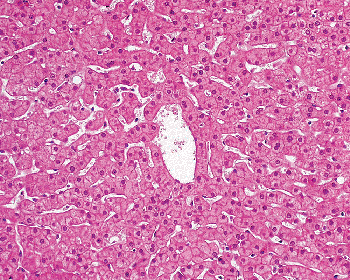 |
Figure 28.5 Terminal hepatic venule surrounded by converging hepatocyte plates and sinusoids. |
The individual hepatocyte is a polygonal epithelial cell approximately 25 m in diameter with a well-defined plasma membrane that is differentiated into three specialized regions or domains: basolateral (70% of total surface area), which faces the sinusoid; bile canalicular (15%), bounding that part of the intercellular space that constitutes the bile canaliculi; and lateral (15%), facing the rest of the intercellular space. Each domain has different molecular, chemical, and antigenic compositions and functions.
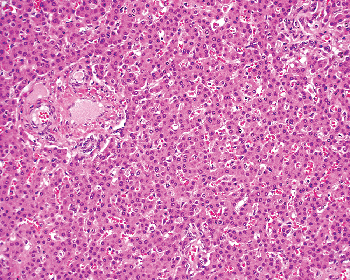 |
Figure 28.6 Liver of a child showing small uniform hepatocytes that are arranged in two-cell thick plates. |
The nucleus is centrally located, round, and contains one or more nucleoli. At birth, all but a few hepatocytes are mononuclear. In adults, although binucleate forms are not uncommon (up to 25% of cells), mitotic activity is rare. Nuclei vary in size in the adult, and the great majority are diploid (36). Some nuclei are larger than others, indicating polyploidy, particularly in persons over 60 years of age (37) (Figure 28.7). The significance of polyploidy is unknown and is usually more marked in the midzonal area. Since cell size is proportional to cell ploidy, polyploidy does not provide an increased quantity of genetic material per unit volume of cytoplasm. The hepatocytes in the portal limiting plates are smaller than other parenchymal cells with more intense nuclear staining and more basophilic cytoplasm. Nuclear displacement to the sinusoidal pole with hyperchromasia is a cytological indication of regenerative activity.
The abundant cytoplasm is eosinophilic and contains fine basophilic granules representing rough endoplasmic reticulum. Cytoplasmic glycogen is present and after proper fixation is stainable with periodic acid-Schiff (PAS) reagent. On hematoxylin and eosin (H&E) preparations, glycogen gives a fine, reticulated, foamy appearance to the cytoplasm. The quantity and distribution of glycogen show diurnal and diet-related variations. An irregular distribution pattern may sometimes be found in biopsies and is not of diagnostic significance (Figure 28.8). Glycogen accumulation in hepatocyte nuclei around portal tracts produces a vacuolated appearance (Figure 28.9) and is common in adolescents. In adults, such an appearance may be conspicuous in
P.690
conditions such as diabetes mellitus, pancreatic carcinoma, and chronic heart failure but is usually of no diagnostic significance.
 |
Figure 28.7 Liver of a 65-year-old patient showing significant polyploidy of hepatocyte nuclei (arrow) and binucleate forms (arrowhead). |
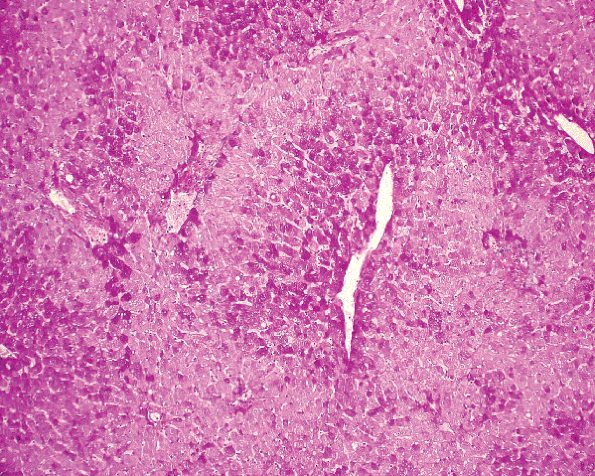 |
Figure 28.8 Periodic acid-Schiff reaction shows irregular distribution of glycogen (darker color) in the hepatocytes. |
A few vacuoles and small quantities of stainable iron are common in normal hepatocytes, particularly in older individuals. Hemosiderin and copper are abundant in the cytoplasm of hepatocytes during the first week of life, then gradually disappear and should be absent at the age of 6 to 9 months.
Lipofuscin, the wear and tear pigment, is seen in varying quantities as fine, well-delineated, light brown, PAS-positive diastase-resistant, partly acid-fast positive granules in the cytoplasm of hepatocytes in zone 3, particularly at the canalicular pole (Figure 28.10). There is a progressive increase of its amount in individual hepatocytes and in the number of cells involved in older individuals. It is rich in oxidized lipids accumulating in secondary lysosomes as a result of autophagy and uptake of exogenous substances. It is not found in recently regenerated hepatocytes. It may be difficult to distinguish lipofuscin from the pigment that accumulates in hepatocytes in large amounts in Dubin-Johnson syndrome.
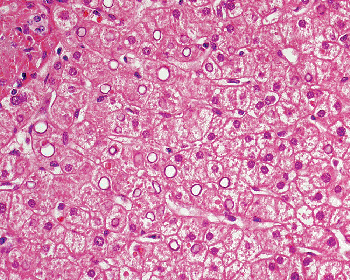 |
Figure 28.9 Glycogen accumulation in hepatocyte nuclei resulting in clear, empty appearance. |
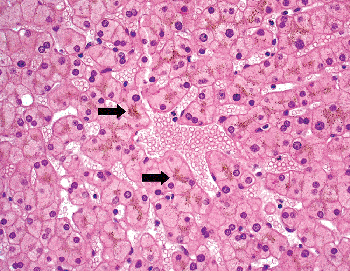 |
Figure 28.10 Lipofuscin in hepatocytes of zone 3 of the acinus. The finely granular pigment accumulates along the bile canaliculi (arrows). |
In contrast to lipofuscin, iron and copper are coarser, birefringent, and usually deposited in periportal hepatocytes. Intracellular bile is poorly defined and less granular than the other pigments and often forms thrombi in bile canaliculi in zone 3 (38) (Figure 28.11). Isolated eosinophilic bodies as a result of coagulative necrosis, rare
P.691
apoptotic bodies representing normal turnover of hepatocytes (15), and an occasional focal necrosis where chronic inflammatory cells replace a few necrotic hepatocytes are not unusual in otherwise apparently normal livers.
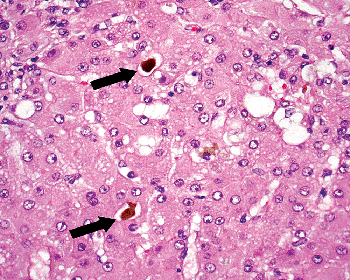 |
Figure 28.11 Canalicular bile thrombi (arrows) in zone 3 of the acinus. |
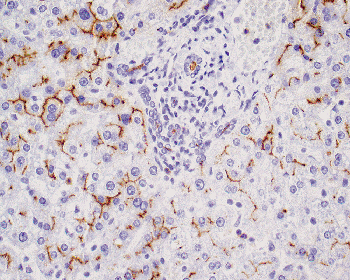 |
Figure 28.12 CD10 immunostaining delineates the twig-like structures of bile canaliculi, as well as the lumen of bile ducts and ductules. |
The bile canaliculus is an intercellular space with a diameter of approximately 1 m, formed by the apposition of the edges of gutterlike hemicanals on adjacent surfaces of two or three neighboring hepatocytes. Bile canaliculi are not readily recognized under the light microscope unless distended in conditions with parenchymal cholestasis, which is accompanied by hepatocyte rosetting. Bile canaliculi form a chicken wire like network in the center of the hepatic plates, which can be demonstrated immunohistochemically with polyclonal anticarcinoembryonic antigen (pCEA) or CD10 (Figure 28.12). Bile canaliculi connect to bile ductules via canals of Hering.
Sinusoidal Lining Cells
In normal liver biopsy specimens, sinusoids are slitlike spaces that contain a few blood cells. The periportal sinusoids are more tortuous than the perivenular ones.
Hepatic sinusoids separate cords of hepatocytes and are lined by sinusoidal lining cells supported by reticulin fibers (Figure 28.13). These cells, which include endothelial and Kupffer cells, constitute a coordinated defense system. They are not conspicuous in normal biopsy specimens. The endothelial cells have thin, indistinct cytoplasm and small, elongated, darkly stained nuclei without nucleoli. The sievelike plates of the endothelial cytoplasm and the absence of a structurally defined basement membrane (in contrast to capillaries) facilitate exchange between blood and hepatocytes (20,39,40).
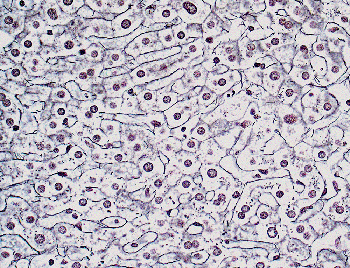 |
Figure 28.13 Hepatic sinusoids lined by reticulin fibers in a normal liver (reticulin stain). |
The Kupffer cells have a bean-shaped nucleus and plump cytoplasm with star-shaped extensions (41). They are more numerous near the portal tracts. They belong to the mononuclear-phagocytic system and are derived in part from the bone marrow. They contain vacuoles and, particularly in the diseased liver, many diastase-resistant PAS (PAS-D) positive lysosomes and phagosomes, as well as acid-fast granular aggregates of ceroid pigment. These cells respond actively to many types of injury by proliferation and enlargement.
Between the endothelial cells and the hepatocytes lies the space of Disse, a zone of rapid intercellular exchange. It contains plasma, scanty connective tissue that constitutes the normal framework of the liver, and perisinusoidal cells such as hepatic stellate cells (Ito cells, interstitial fat-storing cells, or hepatic lipocytes) and pit cells. The connective tissue fibers along the sinusoids represent predominantly collagen type III, which stains black in silver impregnations (reticulin) and forms a regular network radiating from the center of the lobules. Elastic fibers and basement membranes are absent from normal sinusoids (42,43). The space of Disse is not discernible in well-fixed, normal liver biopsy material; but in postmortem liver, the hepatocytes shrink, pericellular edema develops, and the space becomes more conspicuous (Figure 28.14).
On light microscopy, hepatic stellate cells (44) are difficult to differentiate from sinusoidal lining cells. They are modified resting fibroblasts that can store fat and vitamin A and produce hepatocyte growth factor (45) and collagen. They play a significant role in hepatic fibrogenesis. When loaded with fat, such as in hypervitaminosis A, they may be recognized due to cytoplasmic fat droplets of rather uniform size with scalloping of the elongated nucleus (Figure 28.15). When activated, these cells contain stainable desmin and actin in their cytoplasm (46), justifying their designation as myofibroblasts.
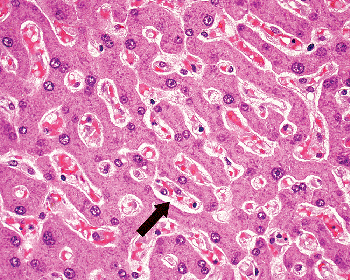 |
Figure 28.14 Autopsy liver specimen exhibiting dilatation of sinusoids and Disse's space (arrow) with prominent sinusoidal lining cells including endothelial and Kupffer cells. |
P.692
Pit cells (47,48) have not been characterized by light microscopy. Under the electron microscope, they have neurosecretory-like electron-dense granules and rod-cored vesicles. Recent evidence indicates that pit cells are not endocrine cells but correspond to the large granular lymphocytes and have natural killer cell activity (49). Occasional inflammatory cells, lymphocytes, or polymorphonuclear leukocytes may be present in the sinusoids. During the first few weeks after birth, the presence of foci of extramedullary hematopoietic cells in the sinusoids and wall of terminal hepatic venules is a normal feature.
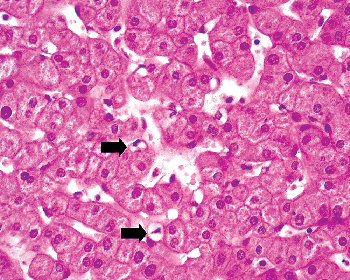 |
Figure 28.15 Prominent lipocytes in liver biopsy specimen of patient with hypervitaminosis A. The nuclei of the lipocytes are scalloped (arrows) due to fat droplets in cytoplasm. |
Hepatic Veins
The intrahepatic course of the valveless hepatic veins, which are embedded in a thin sheath of connective tissue, is straight to the inferior vena cava. The smaller branches (or sublobular veins) and the smallest efferent veins (or terminal hepatic venules) are in direct contact with the hepatic parenchyma. There is a defined spatial relationship between the terminal hepatic venules and the branches of the portal vein and hepatic artery in the portal tracts, which interdigitate but do not directly connect in the three-dimensional space.
The distance between two terminal hepatic venules represents the size of an acinus. The terminal hepatic venules have a very thin wall (Figure 28.5) lined by endothelial cells, which is readily demonstrable after staining with trichrome for collagen or Victoria blue for elastic fibers, but they do not have an adventitia around their wall (50).
It has been suggested that perivenular sclerosis in alcoholic patients may be an index of progressive liver injury (50), although this has been disputed subsequently (51). Thickening of the wall of terminal hepatic venules is often part of pericellular fibrosis and central hyalin sclerosis in alcoholic liver disease (51). It may be seen focally in apparently normal individuals, as well as in children up to 2 years of age.
Portal Tracts
Each portal tract contains a bile duct and several bile ductules, a hepatic artery branch, a portal vein branch, and lymphatic channels embedded in connective tissue (Figure 28.16). The amount of connective tissue and the size of the intraportal structures depend on the size of the portal tract.
P.693
Nerve fibers, both sympathetic and parasympathetic for innervation of blood vessels and bile ducts, can be seen in large portal tracts. The largest portal tracts are round or triangular, the smaller ones are triangular or branching, and the smallest terminal divisions are round or oval. The size of a portal tract is approximately three to four times the diameter of the hepatic artery branch. They normally contain a few lymphocytes, macrophages, and mast cells, but no polymorphonuclear leukocytes or plasma cells. The number of inflammatory cells increases with age. However, their density varies from one portal tract to the next. The connective tissue consists mainly of collagen type I, which is seen as thick, deep blue fibers on the trichrome stain (Figure 28.17). Newly formed collagen type III appears as fine, light blue fibers. In the subcapsular region of the liver, the portal tracts contain more and denser connective tissue. Irregular extensions of fibrous tissue from Glisson's capsule into the parenchyma, sometimes connecting adjacent portal tracts, must not be interpreted as cirrhosis in wedge or superficial biopsy specimens of subcapsular parenchyma (52).
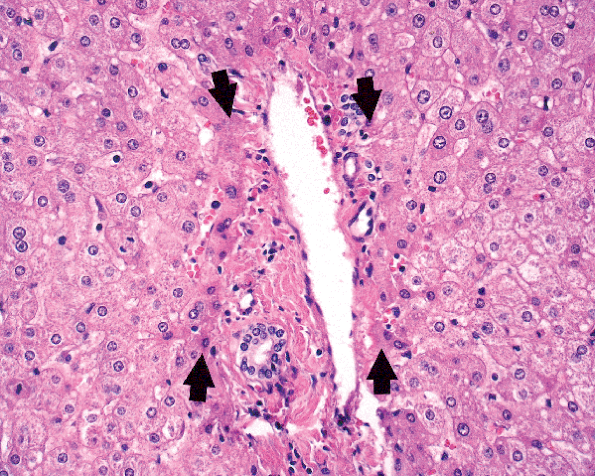 |
Figure 28.16 Normal portal tract with bile duct, hepatic arteriole, portal venule, and clearly defined limiting plate (arrows). |
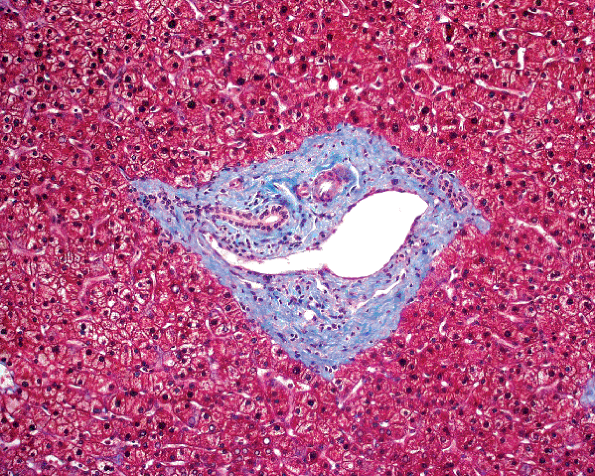 |
Figure 28.17 The connective tissue of portal tracts consists of mainly collagen type I, which appears as thick, deep blue fibers on trichrome stain. |
Bile Ducts
The larger intrahepatic or septal bile ducts are lined by tall columnar epithelial cells measuring about 10 mm in diameter with basally situated, pale, oval nuclei and light eosinophilic cytoplasm (53,54) (Figure 28.18). They have an internal diameter greater than 100 m and a distinct basement membrane stainable with PAS-D. Lymphocytes may occasionally be present within the lining epithelium. The larger bile ducts are located in the central part of the portal tracts and have more periductal fibrous tissue than the smaller ones. The collagen fibers are arranged in an irregular and circumferential but not concentric manner, as may be seen in chronic biliary tract diseases such as primary sclerosing cholangitis and as a sequela of chronic cholecystitis.
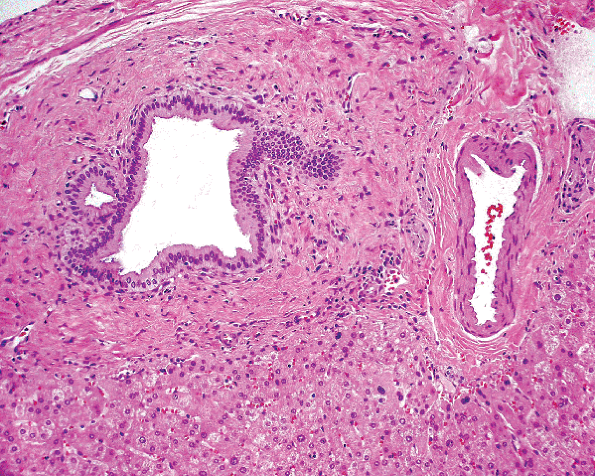 |
Figure 28.18 A large portal tract containing an artery and a bile duct lined by columnar epithelial cells. |
The smaller or interlobular bile ducts are lined by cuboidal or low columnar epithelium. They have a basement membrane and a small amount of periductal connective tissue. One or more interlobular ducts may be present in a portal tract. Bile ducts are always accompanied by a portal vein and a hepatic artery, the latter having approximately the same diameter as the bile duct (external caliber ratio of bile duct to artery is 0.7:0.8) (54) (Figure 28.19). The bile ducts are connected to the bile canaliculi by bile ductules and canals of Hering.
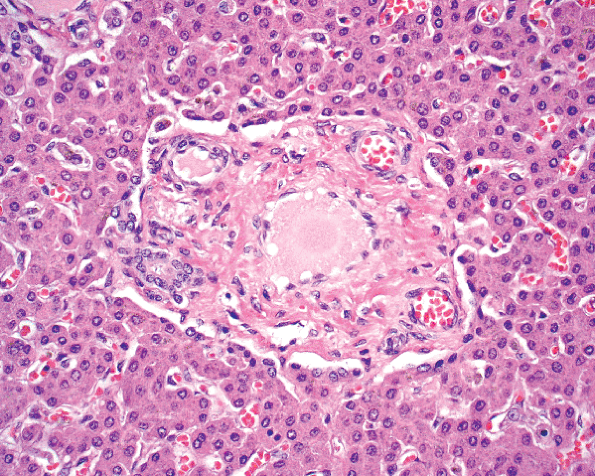 |
Figure 28.19 Normal portal tract in a newborn, with bile ducts and their corresponding hepatic arterioles of approximately the same diameter. |
 |
Figure 28.20 Bile ductules (arrowheads) are located in the peripheral zone of the portal tract and are smaller than the bile ducts (arrows). |
P.694
Bile ductules are located in the peripheral zone of the portal tracts and are smaller (lumen of less than 20 m) than the interlobular bile ducts (Figure 28.20). They have a basement membrane, are lined by cuboidal cholangiocytes, and are accompanied by a portal vein but not by a hepatic artery branch. Bile ductules may be observed at the edge of the portal tract stroma or may transverse the limiting plate, in which case it will have an intralobular as well as an intraportal segment. Ductular reaction, or proliferation of bile ductules, occurs in a variety of chronic liver diseases and can be so extensive as to raise the question of adenocarcinoma (55). Proliferating bile ductules should be differentiated from ductular hepatocytes, which are seen in zone 1 of the liver acini in massive hepatic necrosis (56). Canals of Hering, which are the physiologic link between hepatocyte canaliculi and the biliary tree, are not discernible on routine sections of normal liver. They are lined partly by cholangiocytes and partly by hepatocytes not by cells of intermediate morphology, which are not identified in normal livers (57). They can be demonstrated by staining for high-molecular weight cytokeratin polypeptides (CK7, CK19), which are prominent in all cells of ductal origin (Figure 28.21).
Portal Vein and Hepatic Artery
The lymphatic vessels in portal tracts drain the spaces of Disse. The lymph flows in the same direction as the bile, opposite to that of the blood. The hepatic artery branches are intimately related to the corresponding portal veins. They may show thickening and hyalinization of the wall in older persons, although these changes are usually milder than in other organs. The terminal hepatic arterioles regulate the parenchymal blood supply with their muscular sphincter (58), whereas the portal venous supply is controlled by mesenteric venous blood flow.
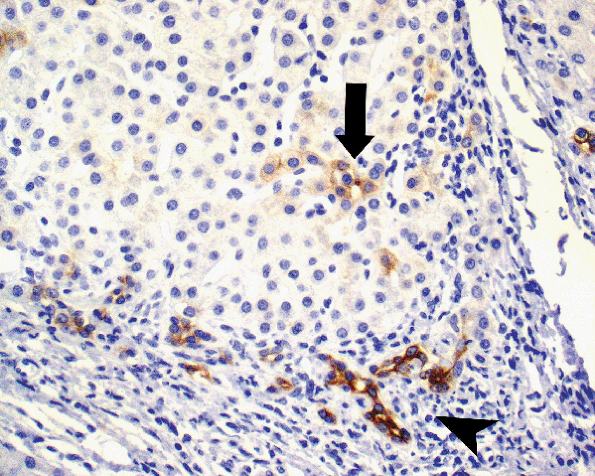 |
Figure 28.21 Proliferating bile ductules and hepatocytes undergoing ductular metaplasia (arrow) in chronic cholestasis are stained brown with anti-CK7. |
The portal veins are the largest vessels in the portal tracts and produce venules that empty into periportal sinusoids. In contrast to hepatocytes around the terminal hepatic venules, the hepatocytes bordering the portal tracts are joined together and form a distinct row called the limiting plate (59). Destruction of this limiting plate by necroinflammation and/or apoptosis is a hallmark of chronic hepatitis (piecemeal necrosis/interface hepatitis) (Figure 28.22).
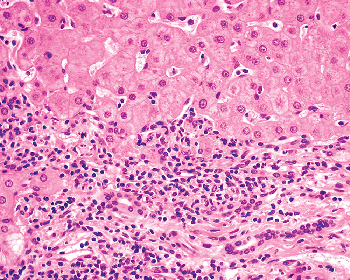 |
Figure 28.22 Liver from a patient with chronic hepatitis showing destruction of the limiting plate by extension of inflammatory cells from the portal tract into the periportal parenchyma with necrosis/apoptosis of hepatocytes (piecemeal necrosis/interface hepatitis). |
P.695
Extracellular Matrix
Both interstitial and basement membrane collagens are present in the liver and play an important role, not only as structural elements but also in hepatic function (60). Collagen I the main component of the dense, birefringent connective tissue fibers is seen mainly in portal tracts and walls of hepatic veins and rarely in the normal parenchyma, whereas collagen III and IV are present along the sinusoids (5). Collagen I can be demonstrated with connective tissue stains; collagen III can be seen with silver impregnation for reticulin. Collagen II, characteristic of cartilage, is absent from the liver. Collagens IV and V, the basement membrane collagens, and laminin are seen in the basement membrane of vessels, bile ducts, and bile ductules but (except for some collagen IV) not along the sinusoids of normal human liver (42,60). Distribution of elastic fibers in the liver, as demonstrated by orcein, resorcin, or Victoria blue stains, seems to follow that of collagen I (43). Fibronectin, an extracellular matrix glycoprotein, is present diffusely along the sinusoidal surface of hepatocytes and in portal tracts together with the other collagens (61). All components of the extracellular matrix are visualized best by immunohistochemical staining using specific antibodies.
Methodology
Specimen Handling
At the time of the biopsy procedure, the needle liver biopsy specimen is immediately examined for adequacy. It should be at least 1.5 cm in total length; otherwise, another pass is recommended. Adequate size of the specimen minimizes sampling error.
After the biopsy procedure (62,63), the liver specimen should be handled as little as possible and with utmost care to avoid squeezing and drying artifacts. If the case so indicates, small pieces of liver tissue may be frozen for histochemistry, immunohistochemistry, chemical analysis or fixed in glutaraldehyde for electron microscopy. If required, cultures should be taken. Then the tissue should be transferred quickly into the appropriate fixative solution, usually 10% buffered formalin. Needle biopsy specimens may be arranged on a piece of card to prevent distortion and fragmentation. At this stage, the gross appearance of the liver specimen is noted. Particular attention should be paid to fragmentation, which suggests cirrhosis, and to the number, size, shape, and color of the fragments. Tumors or granulomas, for example, can be recognized as white areas in an otherwise reddish brown tissue. Gray-black discoloration is seen in Dubin-Johnson syndrome, rusty brown in hemochromatosis, green in cholestasis, and yellow in steatosis or in older individuals from the lipofuscin deposition.
Needle biopsy specimens are fixed for at least three hours at room temperature, whereas wedge biopsy specimens, after sectioning into 2-mm thick slices, need longer fixation. Formalin penetrates most tissues at about 0.5 mm per hour at room temperature. In order to avoid shrinkage and hardening of the tissue, it is important to process liver specimens separately from other tissues and on a more rapid schedule in the automated tissue processor. Rush liver biopsy specimens are manually processed to shorten the time schedule to meet the needs of critically ill patients. More than 10 consecutive sections, 3 to 5 m in thickness, can be cut without artifact from well-embedded specimens. Usually paraffin is used for embedding, but plastic embedding may be used to obtain thinner sections.
Special Stains
The tissue is routinely stained with H&E. Masson's trichrome, Sirius red, or chromotrope-aniline blue stains are used for fibrous tissue; Victoria blue or orcein is used for hepatitis B surface antigen (HBsAg), elastic fibers, lipofuscin, ceroid, and copper-binding protein; PAS with diastase (PAS-D) is used for glycoproteins, including 1-antitrypsin inclusions (Figure 28.23), ceroid in macrophages (Figure 28.24), basement membranes of bile ducts, cytoplasmic inclusions of cytomegalovirus, and Mycobacterium avium-intracellulare. Stains for reticulin and iron are also important. If it is not possible to perform all these stains, at a minimum a special stain for connective tissue, such as Masson's trichrome, and/or reticulin should be obtained in order to assess the lobular architecture and to facilitate the diagnosis of cirrhosis.
It should be emphasized that an adequate and properly processed liver specimen without artifacts is an important
P.696
prerequisite for the accurate evaluation by an experienced histopathologist, who should be supplied with all relevant clinical and laboratory data.
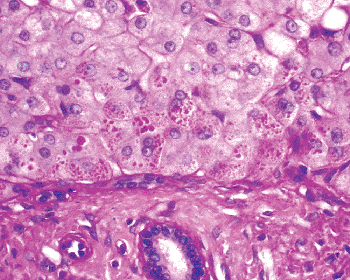 |
Figure 28.23 Alpha-1-antitrypsin granules and globules in periportal hepatocytes (PAS-D). |
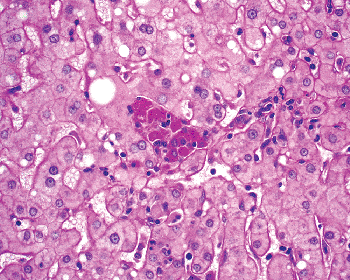 |
Figure 28.24 Ceroid pigment in macrophages as an indicator of previous hepatocyte injury/necrosis (PAS-D). |
Microscopic examination should conform to a routine and include all tissue fragments and all structures of the liver (architecture, portal triads, limiting plate, hepatocytes, sinusoidal cells, and terminal hepatic venules). We usually start with careful examination of zone 3 of the acinus because many changes are found here (congestion, fat, necrosis, cholestasis, pigments, endophlebitis) and then move to the remainder of the parenchyma and portal tracts. Sampling error, particularly in focally or irregularly distributed disease processes, always must be taken into consideration. Squeezing of tissue during the biopsy procedure results in distortion of cells and elongation of nuclei, which makes cytologic evaluation of the specimen difficult (for other artifacts, see section In the Liver at Autopsy below).
Immunohistologic Studies
Recent progress in immunology, particularly the development of monoclonal antibodies and of highly sensitive immunohistochemical staining procedures (peroxidase-antiperoxidase and avidin-biotin-peroxidase complex methods), has made it possible to demonstrate many antigens in routinely processed (i.e., formalin-fixed and paraffin-embedded) tissue sections. Blocking of biotin is often required prior to the application of primary antibodies because hepatocytes contain large amount of endogenous biotin, which can give a false positive reaction; such a false positive is even more pronounced with the use of antigen retrievals (64,65).
Cytokeratins (CK) are the intermediate filaments of epithelial cells and are present in hepatocytes and, in greater amounts, in the bile duct epithelium. Different as well as similar cytokeratins are expressed by hepatocytes and bile ducts. Embryonal hepatocytes contain CK8, CK18, and CK19. The expression of CK19 in hepatocytes dissappears by the tenth week of gestation (66). Mature hepatocytes in the normal liver contain only CK8 and CK18 and thus stain diffusely with keratin CAM 5.2. Cytokeratin staining of hepatocytes is usually more intense in the acinar zone 1. Most hepatocytes also stain with keratin 35 H11, which reacts with CK8 only (67). Hepatocytes do not stain with vimentin, epithelial membrane antigen, CK7, and CK19. HepPar1 stains hepatocytes in a diffuse, granular, cytoplasmic pattern (68,69) (Figure 28.25). Normal hepatocytes do not stain with AFP, but hepatocytes in cirrhotic nodules may occasionally show focal positive staining (70).
Cytokeratin polypeptides may be altered in specific liver diseases such as alcoholic hepatitis with formation of Mallory hyalins (67). Mallory hyalins are composed of heterogenous cytokeratin filament and usually react strongly with antibody to CK18, 34 E12, and CAM 5.2 antibodies and with antibody to ubiquitin (71,72). They also react occasionally with CK7 and CK19.
Bile canaliculi can be demonstrated using pCEA and CD10 (73) (Figure 28.12).
Sinusoidal endothelial cells show phenotypic differences with vascular endothelium. Normally, they do not bind the lectin ulex europaeus; they do not express factor VIII related antigen or contain other molecules found in vascular endothelium, such as CD34 and CD31. They, however, assume these phenotypic properties in chronic liver diseases and in hepatocellular carcinoma (74,75,76).
Several markers of neural/neuroectodermal differentiation have been found in hepatic stellate cells. These are
P.697
synaptophysin, glial fibrillary acidic protein (GFAP), and neural cell adhesion molecule (N-CAM), which can be used to identify resting stellate cells (77,78,79). When activated, these cells show expression of vimentin, desmin, and smooth muscle actin, which suggests myofibroblastic differentiation (46).
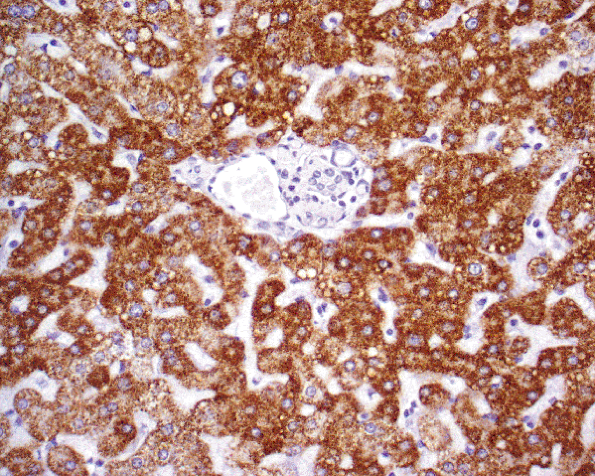 |
Figure 28.25 Granular staining of hepatocytes using HepPar1 antibody excludes other cells and all structures in the portal tract. |
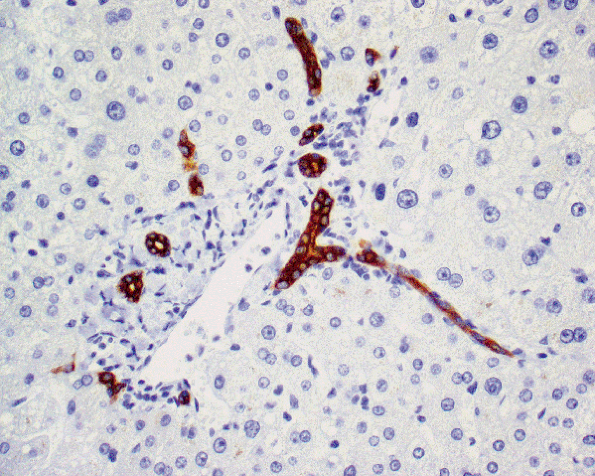 |
Figure 28.26 Cytokeratin 7 immunostaining of bile duct and bile ductules. |
Bile ducts and ductules are readily revealed by immunostaining for bile duct type CK7 and CK19 (80) (Figure 28.26). Cytokeratin 7 immunostaining is useful to evaluate the presence or loss of bile ducts, such as in cholestatic liver diseases and chronic rejection in liver transplantation. Bile ducts also stain with CK8, CK18, AE1/AE3, 35 H11, and 34 E12 antibodies (67). Some hepatocytes in the periphery of cirrhotic nodules may react with keratin AE1/AE3, CK7, and CK19 antibodies, thus suggesting biliary differentiation (81,82) (Figure 28.21).
Detection of the following antigens is useful in the diagnostic evaluation of liver diseases: 1-antitrypsin in PAS-D positive intracytoplasmic globules in periportal hepatocytes of patients with 1-antitrypsin deficiency (Figure 28.18); -fetoprotein in hepatocellular carcinoma; and CEA, CK7, and Lewis blood group antigens in bile duct carcinoma, although CEA is also expressed in some hepatocellular and many other metastatic carcinomas (83,84).
The presence or absence and distribution pattern of viral antigens are helpful in the diagnostic and prognostic evaluation of viral hepatitis, particularly hepatitis B surface (Figure 28.27) and core antigens (Figure 28.28) in hepatitis B virus (HBV) or in dual HBV and HCV (hepatitis C virus) infection. The detection of hepatitis A, C, and delta (D) antigens and of herpesvirus antigens (cytomegalovirus, herpes simplex virus, and Epstein-Barr virus) confirms the cause of acute or chronic hepatitis (85). Since the cloning and sequencing of the HCV genome in 1989, there have been a number of studies for the detection of HCV antigens in the liver. However, the reports are conflicting (86,87,88). The detection rate of positive cases varied, which may be related to tissue sampling and differences in sensitivity of various methods and specificity and/or to avidity of the antibodies. Immunohistochemical studies on frozen sections appeared to demonstrate HCV antigens more reliably than on formalin-fixed, paraffin-embedded sections.
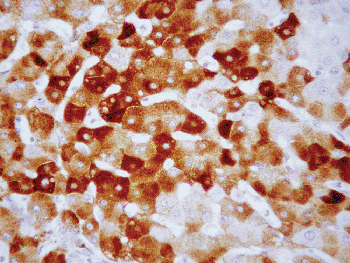 |
Figure 28.27 Immunostaining of hepatitis B surface antigen (HBsAg) in cytoplasm of ground-glass hepatocytes in an asymptomatic HBV carrier. |
The expression of the various components of extracellular matrix in the diseased liver is currently under intensive investigation. It is clear that development of additional monoclonal antibodies to other antigens will further expand the usefulness of immunohistologic stainings to the diagnostic hepatopathologist.
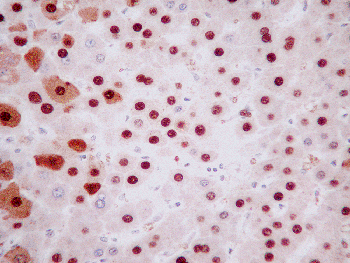 |
Figure 28.28 Immunostaining of hepatitis B core antigen (HBcAg) in numerous nuclei and cytoplasm of hepatocytes of an immunosuppressed patient with high viral replication. |
P.698
Molecular Studies
In situ hybridization for the detection of DNA or RNA may be performed on formalin-fixed, paraffin-embedded tissue sections. In situ hybridization for albumin mRNA is highly specific for normal hepatocytes and hepatocellular tumors (69).
The detection of viral sequences such as those of Epstein-Barr virus and more recently of HCV by in situ hybridization appear to be more sensitive than by immunohistochemical methods (89,90,91). The sensitivity, especially in HCV infection, in which the number of virus in the liver is low, can be further increased by in situ polymerase chain reaction (92).
Aging Changes
There are several changes in the liver related to aging. These are commonly seen in individuals 60 years of age and older. There is more variation in the size of the hepatocytes and their nuclei, similar to that seen in patients on methotrexate, due to increased polyploid cells (93). With aging and atrophy of liver cell cords there may be apparent dilatation of sinusoids. More abundant lipofuscin deposition is present in the centrilobular hepatocytes, and sometimes there are some iron pigments in the periportal hepatocytes. The portal tracts contain denser collagen and may exhibit a higher number of mononuclear inflammatory cells than in younger subjects. The arteries may have thickened walls (Figure 28.29), even in normotensive individuals. These histologic changes of aging need to be kept in mind because they are often present in viable donors for which frozen sections are requested and should not be interpreted as pathologic. These aging-related findings are accompanied by alteration in the metabolic function of the liver, including the metabolism of toxins and drugs (94), and therefore may increase the susceptibility of the liver to hypovolemia and decrease its capacity for regeneration.
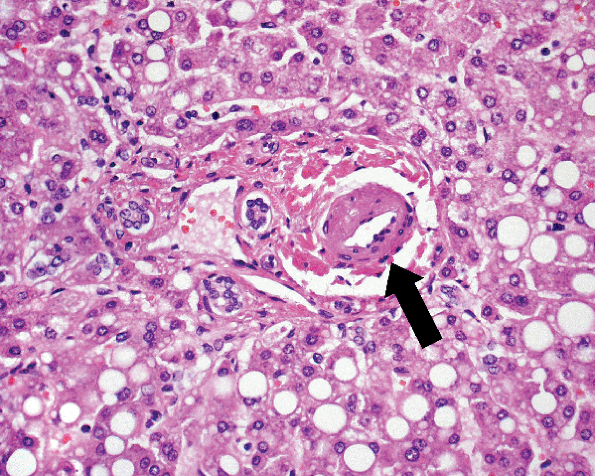 |
Figure 28.29 Thickened hepatic arteriole in an older individual (arrow). |
Frequent Histologic Changes of Little Significance
In the Liver at Autopsy
Liver tissue obtained at autopsy often shows changes that are not usually seen in liver biopsy specimens and therefore may cause difficulties in the evaluation. Agonal loss of glycogen from hepatocytes causes increased density and eosinophilia of the cytoplasm. Poor fixation results in irregular staining of hepatocytes, particularly in the center of the specimen. This may result in striking differences in the appearance of liver cells in the peripheral versus the central part of the tissue.
Agonal necrosis, particularly of hepatocytes in zone 3 in patients with shock or heart failure, may not be reflected in elevated aminotransferase levels (Figure 28.30). Its terminal nature is recognized from the lack of any inflammatory response. Autolysis of hepatocytes, particularly in hepatitis and cholestasis resulting in loss of cellular detail and prominent sinusoidal lining cells, is often more pronounced than in other tissues because the liver is rich in proteolytic enzymes. Loss of inflammatory cells by autolysis may make the diagnosis of hepatitis in postmortem specimens difficult (95). Trichrome stain assists greatly in the identification of portal tracts and central venules (and thus the lobular architecture) and, by demonstrating the fibrous septa, the chronicity of the condition.
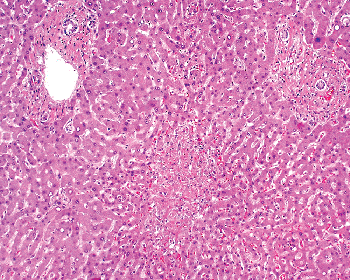 |
Figure 28.30 Agonal necrosis in zone 3 hepatocytes of autopsy liver without inflammatory cells. |
P.699
Dilatation of the sinusoidal and perisinusoidal spaces is of little significance in postmortem liver tissues (Figure 28.14) as opposed to similar changes in well-preserved biopsy specimens. Focal accumulation of lymphocytes in scattered portal tracts is frequently seen in autopsy livers and does not justify the diagnosis of chronic hepatitis. Large tissue sections obtained at autopsy often include many large triangular portal tracts with abundant connective tissue that can be distinguished from true portal fibrosis by evaluation of the size of the intraportal structures. Increased fibrous tissue in portal tracts and parenchyma is a normal phenomenon in older individuals.
In Surgical Liver Biopsy Specimens
Surgical biopsy specimens may have several features not seen in needle biopsy specimens that may cause diagnostic difficulties. If the surgeon removes a small, superficial wedge of liver tissue from the inferior margin, the triangular tissue fragment is covered on two sides by the Glisson's capsule. The fibrous connections between the superficial portal tracts and the capsule may imitate cirrhosis (31) (Figure 28.31). However, these changes usually do not extend more than 2 mm into the liver parenchyma.
In biopsy specimens removed at the end of a long surgical procedure, clusters of polymorphonuclear neutrophils are seen in or under the capsule, in sinusoids, around terminal hepatic venules, in portal tracts, and in areas of small focal necroses resembling microabscesses, probably as a result of minor trauma (96) (Figure 28.32). This characteristic lesion must be distinguished from inflammatory liver diseases such as cholangitis. Other innocent hepatic lesions include focal steatosis involving small groups of hepatocytes, fat granulomas from mineral oil deposition in perivenular areas and in portal tracts; undefined pigmentation, and unexplained mitoses of hepatocytes that normally have a life span of many years.
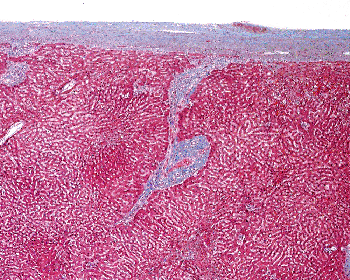 |
Figure 28.31 Surgical liver biopsy specimen showing fibrous connections between the capsule and superficial portal tracts, imitating the picture of cirrhosis (trichrome stain). |
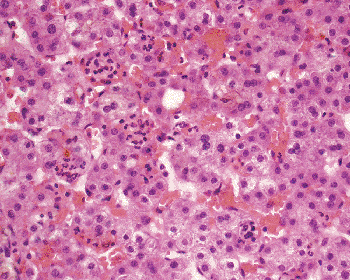 |
Figure 28.32 Surgical liver biopsy specimen showing clusters of polymorphonuclear neutrophils in sinusoids resembling microabscesses (surgical hepatitis). |
Minor but Significant Hepatic Alterations
Nonspecific Reactive Hepatitis
This poorly defined histologic change represents a reaction of the liver to a variety of extrahepatic, particularly febrile, and gastrointestinal diseases. Nonspecific reactive hepatitis must be differentiated from primary liver diseases such as mild chronic hepatitis and residual stages of acute viral hepatitis. The alterations consist of activation of sinusoidal lining cells with prominent Kupffer cells, foci of isolated hepatocyte necrosis with accumulation of macrophages and other inflammatory cells, and mild infiltration of some portal tracts by mononuclear cells, without piecemeal necrosis or interface hepatitis (Figures 28.33,28.34). Scattered hepatocytes also may contain microvesicular or macrovesicular fat droplets.
Nonspecific reactive hepatitis with steatosis, increased variation in size and staining quality of hepatocyte nuclei, sinusoidal dilatation, and poorly developed granulomas are seen in livers of patients with acquired immunodeficiency syndrome (AIDS) (97,98). The granulomas are poorly formed and may be difficult to recognize, but special stains may show the a large number of microorganisms such as M. avium-intracellulare. Although patients with AIDS are often infected with cytomegalovirus, the characteristic intranuclear and cytoplasmic inclusions are
P.700
sometimes not detected in the liver. Instead, focal aggregates of polymorphonuclear leukocytes (so-called microabscesses) may be seen in the lobules at the sites of the degenerated infected hepatocytes or sinusoidal lining cells (98,99) (Figure 28.35).
 |
Figure 28.33 Nonspecific reactive hepatitis characterized by activation of sinusoidal lining cells (arrows). |
Vicinity of Space-Occupying Lesions
Nonspecific reactive changes are also seen in patients with space-occupying lesions in the liver (100). Although the biopsy specimen may not include the neoplasm, the abscess, or the cyst, a characteristic histologic triad is often observed in the adjacent liver. These changes consist of proliferated and distorted bile ductules with irregular and even atypical epithelium accompanied by neutrophils in edematous portal tracts, and focal sinusoidal dilatation and congestion (Figure 28.36). In contrast to large bile duct obstruction and other biliary tract diseases such as primary sclerosing cholangitis, cholestasis is usually absent. In addition, the liver cell plates may be compressed and distorted with atrophy of hepatocytes. These histologic changes are the result of focal obstruction of blood and bile flow by the expanding mass. They may be subtle and are usually focal
P.701
with involvement of small portal tracts. The described triad is characteristic for the vicinity of a space-occupying lesion, and its recognition in a liver specimen should lead to continued search for a neoplasm, cyst, or abscess.
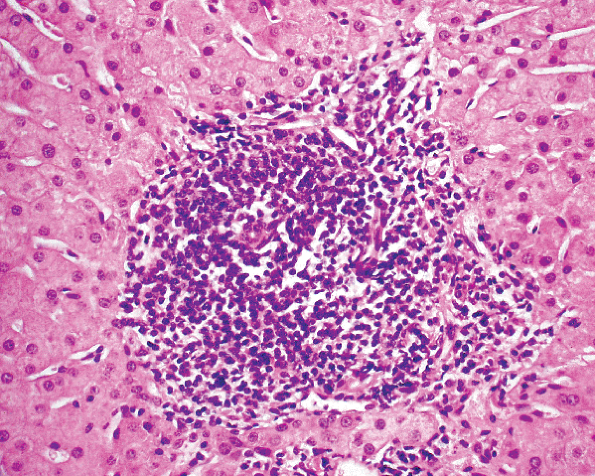 |
Figure 28.34 Dense lymphocytic aggregate in a portal tract with chronic hepatitis C. |
 |
Figure 28.35 Aggregates of polymorphonuclear leukocytes in sinusoid adjacent to a cytomegalovirus-infected cell (arrow). |
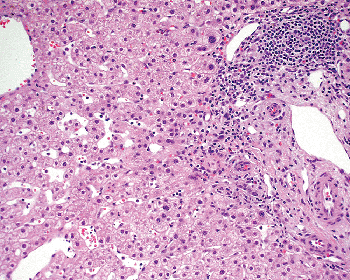 |
Figure 28.36 Liver biopsy specimen of patient with metastatic carcinoma showing dilatation of sinusoids in zone 2, as well as proliferation of bile ductules and infiltration of portal tract by neutrophils. The specimen did not contain metastatic carcinoma, but the histologic changes are consistent with the vicinity of a space-occupying lesion. |
Sinusoidal Dilatation
Acute or chronic venous congestion with dilatation of sinusoids in Rappaport acinus zone 3 and of terminal hepatic venules is frequently seen at autopsy but also in biopsy specimens; it is usually a consequence of right-sided congestive heart failure, whereas irregular necrosis of hepatocytes in zone 3 is often caused by left-sided heart failure or shock (101). In more severe and chronic cases, there is also atrophy of hepatocytes with increased lipofuscin accumulation and scattered small droplet fat vacuoles, enlargement of Kupffer cells containing ceroid pigment, focal cholestasis, and progressive fibrosis in the periphery of the acinus (rather than concentric around the central venules). Engorgement of sinusoids around terminal hepatic venules is also observed in patients with Budd-Chiari syndrome, veno-occlusive disease, sepsis, malignant tumors, so-called collagen diseases, granulomatous diseases, Crohn's disease, and in patients with AIDS (97,102,103,104).
In contrast, dilatation of sinusoids in Rappaport acinus zone 1 has been observed in pregnancy, in renal transplant patients, after exposure to anabolic/androgenic or contraceptive steroids (105,106,107), and near space-occupying lesions (100). After exposure to vinyl chloride, thorotrast, arsenicals, and oral contraceptives, sinusoidal dilatation may be accompanied by hepatocellular and sinusoidal cell hypertrophy, hyperplasia, and dysplasia, increased reticulin fibers along sinusoids, and portal fibrosis (106,107,108).
Acknowledgments
The late Dr. Hans Popper reviewed the manuscript and offered invaluable constructive criticism. The late Dr. Michael Gerber was the senior author of this chapter in the earlier editions. The authors thank Pamela Ramali for revising illustrations in this chapter.
References
1. Desmet VJ, Van Eyken P. Embryology, malformations and malpositions of the liver. In: Haubrich WS, Schaffner F, Berk JE, eds. Bockus Gastroenterology. 5th ed. Philadelphia: WB Saunders; 1995:1849 1857.
2. MacSween RNM, Desmet VJ, Roskams T, Scothorne RJ. Developmental anatomy and normal structure. In: MacSween RNM, Burt AD, Portmann BC, Ishak KG, Scheuer PJ, Anthony PP, eds. Pathology of the Liver. 4th ed. London: Churchill Livingstone; 2002:1 66.
3. Wanless IR. Physioanatomic considerations. In: Schiff ER, Sorrell MF, Maddrey WC, eds. Schiff's Diseases of the Liver. 9th ed. Philadelphia: Lippincott Williams & Wilkins; 2002:1 57.
4. Moore KL, Persaud TVN. The Developing Human: Clinically Oriented Embryology. 7th ed. Philadelphia: WB Saunders; 2003.
5. Hammar JA. Ueber die erste Entstehung der nicht kapillaren intrahepatischen Gallengange beim Menschen. Z Mikrosk Anat Forsch 1926;5:59 89.
6. Desmet VJ. Intrahepatic bile ducts under the lens. J Hepatol 1985;1:545 559.
7. Jorgensen MJ. The ductal plate malformation. Acta Pathol Microbiol Scand Suppl 1977;257:1 88.
8. Terada T, Nakanuma Y. Detection of apoptosis and expression of apoptosis-related proteins during human intrahepatic bile duct development. Am J Pathol 1995;146:67 74.
9. Columbano A, Ledda-Columbano GM, Coni PP, et al. Occurrence of cell death (apoptosis) during the involution of liver hyperplasia. Lab Invest 1985;52:670 675.
10. Columbano A, Ledda-Columbano GM, Rao PM, Rajalakshmi S, Sarma DS. Occurrence of cell death (apoptosis) in preneoplastic and neoplastic liver cells. A sequential study. Am J Pathol 1984;116:441 446.
11. Fukuda K, Kojiro M, Chiu JF. Induction of apoptosis by transforming growth factor- 1 in the rat hepatoma cell line McA-RH7777: a possible association with tissue transglutaminase expression. Hepatology 1993;10:945 953.
12. Oberhammer F, Bursch W, Tiefenbacher R, et al. Apoptosis is induced by transforming growth factor- 1 within 5 hours in regressing liver without significant fragmentation of the DNA. Hepatology 1993;18:1238 1246.
13. Ohno K, Ammann P, Fasciati R, Maier P. Transforming growth factor- 1 preferentially induces apoptotic cell death in rat hepatocytes cultured under pericentral-equivalent conditions. Toxicol Appl Pharmacol 1995;132:227 236.
14. Desmet VJ. Liver lesions in hepatitis B viral infection. Yale J Biol Med 1988;61:61 83.
15. Wyllie AH. Apoptosis: cell death in tissue regulation. J Pathol 1987;153:313 316.
16. Jones AL, Aggeler J. Structure of the liver. In: Haubrich W, Schaffner F, Berk JE, eds. Bockus Gastroenterology. 5th ed. Philadelphia: WB Saunders; 1995:1813 1831.
17. Bismuth H. Surgical anatomy and anatomical surgery of the liver. World J Surg 1982;6:3 9.
18. Emond JC, Renz JF. Surgical anatomy of the liver and its application to hepatobiliary surgery and transplantation. Semin Liver Dis 1994;14:158 168.
19. Behar J. Anatomy and anomalies of the biliary tract. In: Haubrich WS, Schaffner F, Berk JE, eds. Bockus Gastroenterology. 5th ed. Philadelphia: WB Saunders; 1995:2547 2553.
20. Henricksen JH, Horn T, Christoffersen P. The blood-lymph barrier in the liver. A review based on morphological and functional concepts of normal and cirrhotic liver. Liver 1984;4:221 232.
21. Barrowman JA. Hepatic lymph and lymphatics. In: McIntyre N, Benhamou JP, Bircher J, Rizetto M, Rodes J, eds. Oxford Textbook of Clinical Hepatology. Oxford: Oxford University Press; 1991:37 40.
22. Witte MH, Witte CL. Lymphatic system in the liver. In: Abramson DI, Dobrin PB, eds. Blood Vessels and Lymphatics in Organ Systems. New York: Academic Press; 1984.
23. Tiniakos DG, Lee JA, Burt AD. Innervation of the liver: morphology and function. Liver 1996;16:151 160.
24. Friedman JM. Hepatic nerve function. In: Arias IM, Popper H, Jakoby W, Schachter D, Schafritz DA, eds. The Liver, Biology and Pathobiology. New York: Raven Press; 1988:948 959.
25. Dhillon AP, Sankey EA, Wang JH, et al. Immunohistochemical studies on the innervation of human transplanted liver. J Pathol 1992;167:211 216.
26. Henderson JM, Mackay GJ, Lumsden AB, Atta HM, Brouillard H, Kutner MH. The effect of liver denervation on hepatic haemodynamics during hypovolemic shock in swine. Hepatology 1992;15:130 133.
27. Lee JA, Ahmed Q, Hines JE, Burt AD. Disappearance of hepatic parenchymal nerves in human liver cirrhosis. Gut 1992;33:87 91.
28. Hilden M, Christoffersen P, Juhl E, Dalgaard JB. Liver histology in a normal population examinations of 503 consecutive fatal traffic casualties. Scand J Gastroenterol 1977;12:593 597.
P.702
29. Millward-Sadler GH, Jezequel AM. Normal histology and ultrastructure. In: Wright R, Millward-Sadler GH, Alberti KGMM KS, eds. Liver and Biliary Disease. 2nd ed. London: Bailliere Tindall; 1985:13 44.
30. Patrick RS, McGee JO. Normal liver pathology. In: Patrick RS, McGee JO. Biopsy Pathology of the Liver. Philadelphia: JB Lippincott; 1980:4 14.
31. Scheuer P, Lefkowitch JH. The normal liver. In: Scheuer P, Lefkowitch JH, eds. Liver Biopsy Interpretation. 6th ed. London: WB Saunders; 2000:36 50.
32. Rappaport AM. The structural and functional unit in the human liver (liver acinus). Anat Rec 1958;130:673 689.
33. Elias H. A re-examination of the structure of the mammalian liver. I. Parenchymal architecture. Am J Anat 1949;84:311 333.
34. Gumucio JJ, Miller DL. Functional implications of liver cell heterogeneity. Gastroenterology 1981;80:393 403.
35. Terada T, Ishida F, Nakanuma Y. Vascular plexus around intrahepatic bile ducts in normal livers and portal hypertension. J Hepatol 1989;8:139 149.
36. Ranek L, Keiding N, Jensen ST. A morphometric study of normal human liver cell nuclei. Acta Pathol Microbiol Scand A 1975;83:467 476.
37. Findor J, Perez V, Igartua EB, Giovanetti M, Fioravantti N. Structure and ultrastructure of the liver in aged persons. Acta Hepatogastroenterol (Stuttg) 1973;20:200 204.
38. Thung SN, Gerber AM. Differentiation of brown pigments in the liver. In: Thung SN, Gerber MA, eds. Differential Diagnosis in Pathology. Liver Disease. New York: Igaku-Shoin; 1995:66.
39. Jones EA. Hepatic sinusoidal cells: new insights and controversies. Hepatology 1983;3:259 266.
40. Wisse E, De Zanger RB, Charels K, Van Der Smissen, McCuskey RS. The liver sieve: considerations concerning the structure and function of endothelial fenestrae, the sinusoidal wall and the space of Disse. Hepatology 1985;5:683 692.
41. Wisse E, Knook DL. Kupffer Cells and Other Liver Sinusoidal Cells. Amsterdam: Elsevier; 1977.
42. Bianchi FB, Biagini G, Ballardini G, et al. Basement membrane production by hepatocytes in chronic liver disease. Hepatology 1984;4:1167 1172.
43. Thung SN, Gerber MA. The formation of elastic fibers in livers with massive hepatic necrosis. Arch Pathol Lab Med 1982;106:468 469.
44. Kent G, Gay S, Inouye T, Bahu R, Minick OT, Popper H. Vitamin A-containing lipocytes and formation of type III collagen in liver injury. Proc Natl Acad Sci U S A 1976;73:3719 3722.
45. Schirmacher P, Geerts A, Pietrangelo A, Dienes HP, Rogler CE. Hepatocyte growth factor/hepatopoietin A is expressed in fat-storing cells from rat liver but not myofibroblast-like cells derived from fat-storing cells. Hepatology 1992;15:5 11.
46. Ogawa K, Suzuki J, Mukai H, Mori M. Sequential changes of extracellular matrix and proliferation of Ito cells with enhanced expression of desmin and actin in focal hepatic injury. Am J Pathol 1986;125:611 619.
47. Kaneda K, Kurioka N, Seki S, Wake K, Yamamoto S. Pit cell-hepatocyte contact in autoimmune hepatitis. Hepatology 1984;4:955 958.
48. Wisse E, van't Noordende JM, van der Meulen J, Daems WT. The pit cell: description of a new type of cell occurring in rat liver sinusoids and peripheral blood. Cell Tissue Res 1976;173:423 435.
49. Bouwens L, Wisse E. Tissue localization and kinetics of pit cells or large granular lymphocytes in the liver of rats treated with biological response modifiers. Hepatology 1988;8:46 52.
50. Van Waes L, Lieber CS. Early perivenular sclerosis in alcoholic fatty liver: an index of progressive liver injury. Gastroenterology 1977;73(pt 1):646 650.
51. Nasrallah SM, Nassar VH, Galambos JT. Importance of terminal hepatic venule thickening. Arch Pathol Lab Med 1980;104:84 86.
52. Petrelli M, Scheuer PJ. Variation in subcapsular liver structure and its significance in the interpretation of wedge biopsies. J Clin Pathol 1967;20:743 748.
53. International Group. Histopathology of the intrahepatic biliary tree. Liver 1983;3:161 175.
54. Nakanuma Y, Ohta G. Histometric and serial section observations of the intrahepatic bile ducts in primary biliary cirrhosis. Gastroenterology 1979;76:1326 1332.
55. Thung SN, Gerber MA. Adenocarcinoma vs. proliferating bile ductules vs. ductular hepatocytes. In: Thung SN, Gerber MA, eds. Differential Diagnosis in Pathology. Liver Disorders. New York: Igaku-Shoin; 1995:128 129.
56. Rubin EM, Martin AA, Thung SN, Gerber MA. Morphometric and immunohistochemical characterization of human liver regeneration. Am J Pathol 1995;147:397 404.
57. Roskams TA, Theise ND, Balabaud C, et al. Nomenclature of the finer branches of the biliary tree: canals, ductules, and ductular reactions in human livers. Hepatology 2004;39:1739 1745.
58. Yamamoto K, Sherman I, Phillips MJ, Fisher MM. Three-dimensional observations of the hepatic arterial terminations in rat, hamster and human liver by scanning electron microscopy of microvascular casts. Hepatology 1985;5:452 456.
59. Elias H. Anatomy of the liver. In: Rouler C, ed. The Liver: Morphology, Biochemistry, Physiology. Vol 1. New York: Academic Press; 1963:41 52.
60. Popper H, Martin GR. Fibrosis of the liver: the role of the ectoskeleton. In: Popper H, Schaffner F, eds. Progress in Liver Disease. Vol 7. New York: Grune & Stratton; 1982:133 156.
61. Hahn E, Wick G, Pencev D, Timpl R. Distribution of basement membrane proteins in normal and fibrotic human liver: collagen type IV, laminin and fibronectin. Gut 1980;21:63 71.
62. Thung SN, Schaffner F. Liver biopsy. In: MacSween RNM, Anthony PP, Scheuer PJ, Burt AP, Portmann BC, eds. Pathology of the Liver. 3rd ed. London: Churchill Livingstone; 1994:787 796.
63. Antonio LB, Suriawinata A, Thung SN. Liver tissue processing techniques. In: Odze RD, Goldblum JR, Crawford JM, eds. Surgical Pathology of the Gastrointestinal Tract, Liver, Biliary Tract, and Pancreas. Philadelphia: WB Saunders; 2003:739 756.
64. Bussolati G, Gugliotta P, Volante M, Pace M, Papotti M. Retrieved endogenous biotin: a novel marker and a potential pitfall in diagnostic immunohistochemistry. Histopathology 1997;31:400 407.
65. Dodson A, Campbell F. Biotin inclusions: a potential pitfall in immunohistochemistry avoided. Histopathology 1999;34:178 179.
66. Desmet VJ, Van Eyken P, Sciot R. Cytokeratins for probing cell lineage relationships in developing liver. Hepatology 1990;12:1249 1251.
67. Lai YS, Thung SN, Gerber MA, Chen ML, Schaffner F. Expression of cytokeratins in normal and diseased livers and in primary liver carcinomas. Arch Pathol Lab Med 1989;113:134 138.
68. Wennerberg AE, Nalesnik MA, Coleman WB. Hepatocyte paraffin 1: a monoclonal antibody that reacts with hepatocytes and can be used for differential diagnosis of hepatic tumors. Am J Pathol 1993;143:1050 1054.
69. Kakar S, Muir T, Murphy LM, Lloyd RV, Burgart LJ. Immunoreactivity of Hep Par 1 in hepatic and extrahepatic tumors and its correlation with albumin in situ hybridization in hepatocellular carcinoma. Am J Clin Pathol 2003;119:361 366.
70. Theise ND, Fiel IM, Hytiroglou P, et al. Macroregenerative nodules in cirrhosis are not associated with elevated serum or stainable tissue alpha-fetoprotein. Liver 1995;15:30 34.
71. Van Eyken P, Sciot R, Desmet VJ. A cytokeratin immunohistochemical study of alcoholic liver disease: evidence that hepatocytes can express bile duct-type cytokeratins. Histopathology 1988;13:605 617.
72. Hazan R, Denk H, Franke WW, Lackinger E, Schiller DL. Change of cytokeratin organization during development of Mallory bodies as revealed by a monoclonal antibody. Lab Invest 1986;54:543 553.
73. Borscheri N, Roessner A, Rocken C. Canalicular immunostaining of neprilysin (CD10) as a diagnostic marker for hepatocellular carcinomas. Am J Surg Pathol 2001;25:1297 1303.
74. Terayama N, Terada T, Nakanuma Y. An immunohistochemical study of tumour vessels in metastatic liver cancers and the surrounding liver tissue. Histopathology 1996;29:37 43.
P.703
75. Ruck P, Xiao JC, Kaiserling E. Immunoreactivity of sinusoids in hepatocellular carcinoma. An immunohistochemical study using lectin UEA-1 and antibodies against endothelial markers, including CD34. Arch Pathol Lab Med 1995;119:173 178.
76. Haratake J, Scheuer PJ. An immunohistochemical and ultrastructural study of the sinusoids of hepatocellular carcinoma. Cancer 1990;65:1985 1993.
77. Neubauer K, Knittel T, Aurisch S, Fellmer P, Ramadori G. Glial fibrillary acidic protein a cell type specific marker for Ito cells in vivo and in vitro. J Hepatol 1996;24:719 730.
78. Cassiman D, van Pelt J, De Vos R, et al. Synaptophysin: a novel marker for human and rat hepatic stellate cells. Am J Pathol 1999;155:1831 1839.
79. Knittel T, Aurisch S, Neubauer K, Eichhorst S, Ramadori G. Cell-type-specific expression of neural cell adhesion molecule (N-CAM) in Ito cells of rat liver. Up-regulation during in vitro activation and in hepatic tissue repair. Am J Pathol 1996;149:449 462.
80. Rubio CA. The detection of bile ducts in liver biopsies by cytokeratin 7. In Vivo 1998;12:183 186.
81. Hurlimann J, Gardiol D. Immunohistochemistry in the differential diagnosis of liver carcinomas. Am J Surg Pathol 1991;15:280 288.
82. Van Eyken P, Sciot R, Desmet VJ. A cytokeratin immunohistochemical study of cholestatic liver disease: evidence that hepatocytes can express bile duct-type cytokeratins. Histopathology 1989;15:125 135.
83. Thung SN, Gerber MA, Sarno E, Popper H. Distribution of five antigens in hepatocellular carcinoma. Lab Invest 1979;41:101 105.
84. Gerber MA, Thung SN, Shen SC, Stromeyer FW, Ishak KG. Phenotypic characterization of proliferation: antigenic expression by proliferating epithelial cells in fetal liver, massive hepatic necrosis, and nodular transformation of the liver. Am J Pathol 1983;110:70 74.
85. Gerber MA, Thung SN. The diagnostic value of immunohistochemical demonstration of hepatitis viral antigens in the liver. Hum Pathol 1987;18:771 774.
86. Blight K, Lesniewski RR, LaBrooy JT, Gowans EJ. Detection and distribution of hepatitis C-specific antigens in naturally infected livers. Hepatology 1994;20:553 557.
87. Krawczynski K, Beach MJ, Bradley DW, et al. Hepatitis C virus antigen in hepatocytes: immunomorphologic detection and identification. Gastroenterology 1992;103:622 629.
88. Tsutsumi M, Urashima S, Takada A, Date T, Tanaka Y. Detection of antigens related to hepatitis C virus RNA encoding the NS5 region in the livers of patients with chronic type C hepatitis. Hepatology 1994;19:265 272.
89. Negro F, Pacchioni D, Shimizu Y, et al. Detection of intrahepatic replication of hepatitis C virus RNA by in situ hybridization and comparison with histopathology. Proc Natl Acad Sci U S A 1992;89:2247 2251.
90. Tanaka Y, Enomoto N, Kojima S, et al. Detection of hepatitis C virus RNA in the liver by in situ hybridization. Liver 1993;13:203 208.
91. Lones MA, Shintaku IP, Weiss LM, Thung SN, Nichols WS, Geller SA. Posttransplant lymphoproliferative disorder in liver allograft biopsies: a comparison of three methods for the demonstration of Epstein-Barr virus. Hum Pathol 1997;28:533 539.
92. Nuovo GJ, Lidonnici K, MacConnell P, Lane B. Intracellular localization of polymerase chain reaction (PCR)-amplified hepatitis C cDNA. Am J Surg Pathol 1993;17:683 690.
93. Watanabe T, Tanaka Y. Age-related alterations in the size of human hepatocytes. A study of mononuclear and binucleate cells. Virchows Arch B Cell Pathol Incl Mol Pathol 1982;39:9 20.
94. Popper H. Aging and the liver. In: Popper H, Schaffer F, eds. Progress in Liver Diseases. Vol 8. Orlando: Grune & Stratton; 1986:659 683.
95. Gerber MA. Viral hepatitis in the autopsy specimen. Virchows Arch A Pathol Anat 1971;354:285 292.
96. Christoffersen P, Poulsen H, Skeie E. Focal liver cell necroses accompanied by infiltration of granulocytes arising during operation. Acta Hepatosplenol 1970;17:240 245.
97. Lebovics E, Thung SN, Schaffner F, Radensky PW. The liver in the acquired immunodeficiency syndrome: a clinical and histologic study. Hepatology 1985;5:293 298.
98. Sieratzki J, Thung SN, Gerber MA, Ferrone S, Schaffner F. Major histocompatibility antigen expression in the liver in acquired immunodeficiency syndrome. Arch Pathol Lab Med 1987;111:1045 1049.
99. Bach N, Thung SN, Berk PD. The liver in acquired immunodeficiency syndrome (AIDS). In: Bianchi L, Gerok W, Maier KP, Deinhard FJ, eds. Infectious Diseases of the Liver. Boston: Kluwer Academic; 1990:333 351.
100. Gerber MA, Thung SN, Bodenheimer HC Jr, Kapelman B, Schaffner F. Characteristic histologic triad in liver adjacent to metastatic neoplasm. Liver 1986;6:85 88.
101. Arcidi JM Jr, Moore GW, Hutchins GM. Hepatic morphology in cardiac dysfunction. A clinicopathologic study of 1,000 subjects at autopsy. Am J Pathol 1981;104:159 166.
102. Banks JG, Foulis AK, Ledingham I, MacSween RN. Liver function in septic shock. J Clin Pathol 1982;35:1249 1252.
103. Bruguera M, Aranguibel F, Ros E, Rodes J. Incidence and clinical significance of sinusoidal dilatation in liver biopsies. Gastroenterology 1978;75:474 478.
104. Camilleri M, Schafler K, Chadwick VS, Hodgson HJ, Weinbren K. Periportal sinusoidal dilatation, inflammatory bowel disease, and the contraceptive pill. Gastroenterology 1981;80:810 815.
105. Ishak KG. Hepatic lesions caused by anabolic and contraceptive steroids. Semin Liver Dis 1981;1:116 128.
106. Thung SN, Gerber MA. Precursor stage of hepatocellular neoplasm following long exposure to orally administered contraceptives. Hum Pathol 1981;12:472 474.
107. Winkler K, Poulsen H. Liver disease with periportal sinusoidal dilatation: a possible complication to contraceptive steroids. Scand J Gastroenterol 1975;10:699 704.
108. Popper H, Maltoni C, Selikoff IJ. Vinyl chloride-induced hepatic lesions in man and rodents. A comparison. Liver 1981;1:7 20.